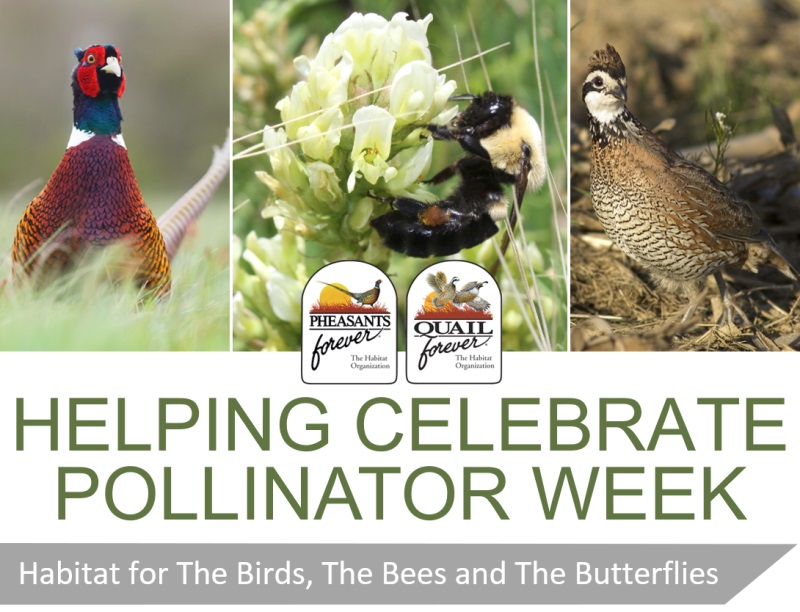 Pheasants Forever and Quail Forever are gearing up to celebrate National Pollinator Week June 18 – 24 by publishing a content series highlighting the importance of pollinator habitat for bees and butterflies, as well as other wildlife — namely upland birds. Articles, videos and social media posts throughout the week will emphasize highly diverse pollinator habitat and its vital, dual role in producing pheasants and quail along with bees, butterflies and a host of other pollinator species.
Pheasants Forever and Quail Forever are gearing up to celebrate National Pollinator Week June 18 – 24 by publishing a content series highlighting the importance of pollinator habitat for bees and butterflies, as well as other wildlife — namely upland birds. Articles, videos and social media posts throughout the week will emphasize highly diverse pollinator habitat and its vital, dual role in producing pheasants and quail along with bees, butterflies and a host of other pollinator species.
The conservation organization’s mission is focused on creating high-quality habitat for pheasants and quail. That very same habitat, filled with diverse grasses and forbs (flowering plants) is critical to a wide array of pollinating insects. For example, monarch butterflies are on the brink of joining the endangered species list. As a natural extension of creating the highest quality habitat for all wildlife, both organizations have made a point of including milkweed in project seed mixes.
“Pheasants Forever and Quail Forever have impacted 155,974 acres for pollinators, including planting more than 643 million milkweed seeds,” stated Drew Larsen, director of habitat education programs for Pheasants Forever and Quail Forever. Putting this number into perspective, the organizations have made noteworthy contributions to the Pollinator Partnership Action Plan designated by the White House in 2016 which calls for one billion new milkweed stems established by 2020.
“While positive for pollinators, these projects also serve as havens for pheasant and quail broods,” continued Larsen, “providing protein-rich insects, as well as excellent hiding cover that chicks can move around in, during critical periods of early development. We look forward to telling our story about bees and butterflies – and birds – during National Pollinator Week.”
National Pollinator Week Content Series
Pheasants Forever and Quail Forever pollinator content will be available as stories and social media posts throughout all of National Pollinator Week at the following locations: PF homepage, PF Facebook, PF Twitter, QF homepage, QF Facebook and QF Twitter.
| June 18: The Birds & The Bees: Article explains how forbs (flowering plants) are the habitat nexus between birds, honey bees and butterflies. |
| June 19: Milkweed, Monarchs and Roosters: Monarch populations have plummeted by 90 percent in the last decade. Through Pheasants Forever’s seed programs and habitat efforts, the organization is leading the nation in putting milkweed back on the landscape for the benefit of monarchs AND game birds. |
| June 20: The Dakota Connection: Each year, honey bees born and raised in North Dakota and South Dakota are shipped across the country to pollinate almond orchards in California and blueberry farms in Maine. Not coincidentally, the same grassland habitat that makes the Dakotas the top two honey bee producing states also makes them the top producing pheasant states. |
| June 21: I-35 Corridor for Pheasants, Quail, and Monarchs: Interstate 35 stretches from Duluth, Minnesota to Dallas, Texas, and cuts through the heart of pheasant and quail country. Not coincidentally, this same highway dissects the heart of America’s monarch habitat and recovery zone. |
| June 22: Roadsides for Wildlife: Ditches and rights-of-way are often the most over-looked habitat opportunities for pheasants, quail, bees and butterflies. Pheasants Forever and Quail Forever are working with state and federal departments of transportation and natural resource agencies to maximize these habitat corridors for a wide array of wildlife species. |
| June 23: Pollinators, Pump Shotguns, and Passing on Traditions: Pheasants Forever and Quail Forever are working with schools and community organizations to plant pollinator plots and engage a new generation in conservation. See how one Nebraska community does it up big. |
| June 24: CRP Works for Pheasants, Quail, Pollinators and You: In the 2016 White House Plan to recover bee and monarch populations, the federal Conservation Reserve Program (CRP) was identified as the single best tool for creating pollinator habitat. |
